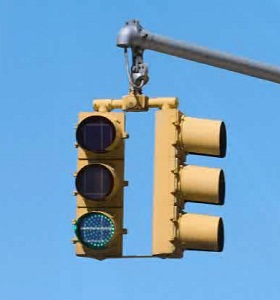University of Nebraska testing hybrid wind/solar traffic lights
 Everybody hates a traffic light when it’s red, gets a little frustrated when it’s yellow and loves when it’s green. Lincoln, Neb., has just installed what’s likely the greenest traffic light—ever, so it should be well loved. It’s powered by the wind and will soon be powered by the sun, too.
Everybody hates a traffic light when it’s red, gets a little frustrated when it’s yellow and loves when it’s green. Lincoln, Neb., has just installed what’s likely the greenest traffic light—ever, so it should be well loved. It’s powered by the wind and will soon be powered by the sun, too.
Right now, the city has installed the first part of the hybrid wind/solar system, a wind turbine with a battery backup system that can power the light-emitting diode (LED) traffic light for up to 16 hours without wind, said Anuj Sharma, professor of civil engineering at the University of Nebraska, who designed the system.
“Right now, we have put in just the wind,” he said. “We haven’t installed the [solar] yet. We’ll be doing it over the summer.”
The size of the photovoltaic array will depend on how much the weight the pole can structurally stand, he said.
The system is also grid-tied, so if there’s no wind or sun for a long period of time to power the system, it can rely on the grid for power. However, Sharma expects the meter to roll backward most of the time.
“For this project, we are aiming for an annual net increase [in power generated],” Sharma said. The net power produced by wind and solar will be sold back to the grid.
In all, the system is expected to cost less than $20,000, according to Sharma.
“This is the first prototype we have set up right now. It is basically a good option in terms of economics,” he said.
The overall cost of equipment for the prototype system is in the range of $10,000 to $15,000. The material costs included a new pole for the wind turbine. He estimated that the photovoltaic aspect of the system will cost $3,000 to $4,000 more.
“We are testing the resources; we may have over-designed the system,” he said.
Such systems would also be ideal for remote locations, where there are no existing power lines. To that end, the university has submitted another research proposal to test such equipment, according to Sharma.
The university is studying the system over a three year period for the Federal Department of transportation, and it will likely work with the city to install two to three more such systems.
The first system was built with off-the-shelf equipment, Sharma said. But the university is designing a system that would use more specialized equipment in an attempt to reduce the cost further.
“If we can use the pole and existing system, we’re hoping to bring it down to $10,000 or even less. The perfect number would be $5,000 to $10,000,” Sharma said. “Compared to intersection installation costs, that is really low.”
Photo illustration by Chris Meehan / CleanEnergyAuthority.



